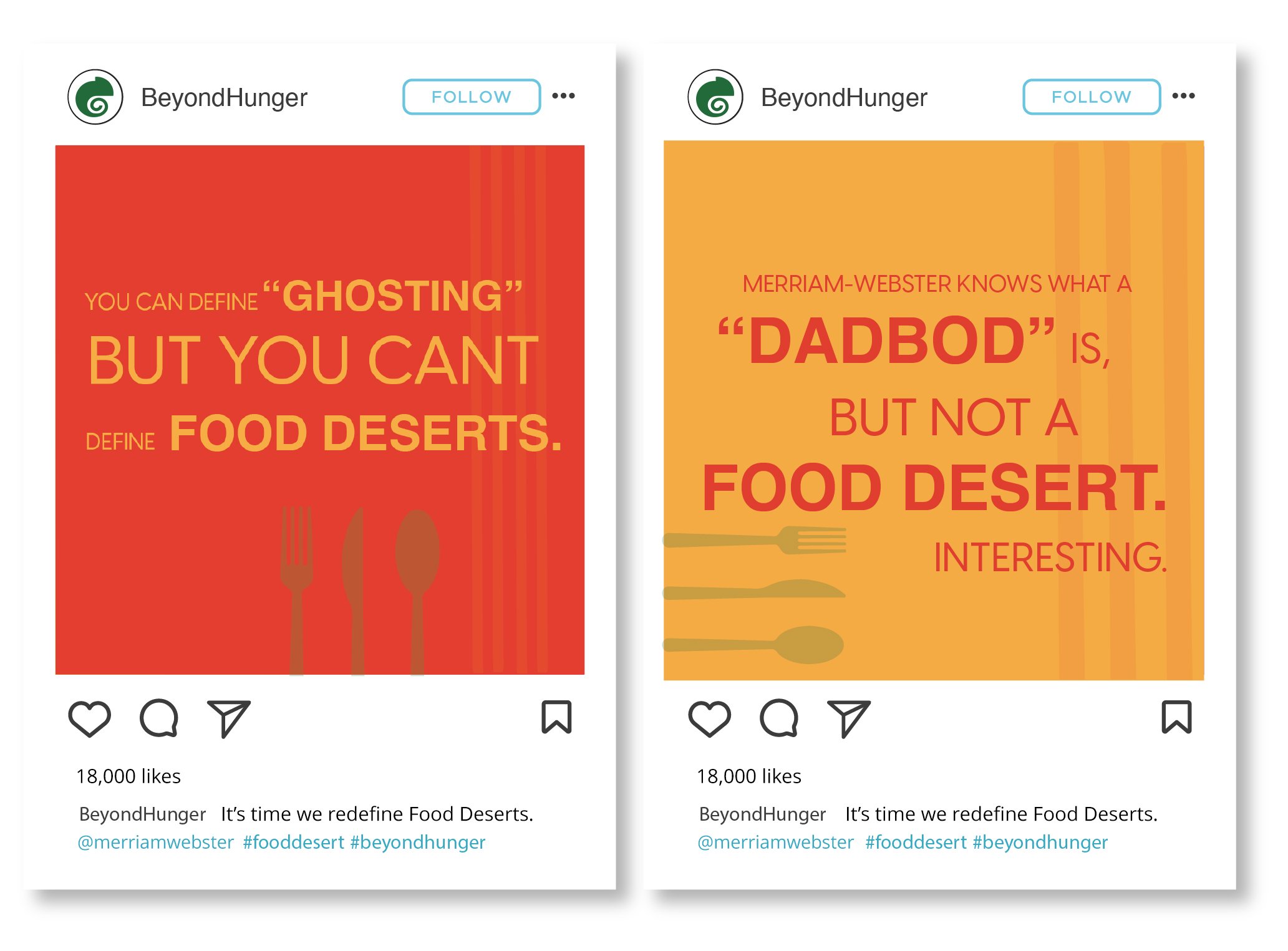
Food Deserts
Greater Good Campaign
In a nutshell
Ask: Develop a campaign that shines a light on the prevalence of food deserts.
Problem: A narrow view of what a food desert is creates narrow-minded solutions and support.
Solution: Redefine the reality of food deserts to generate public awareness and action.
Food desert (noun)
: an area in which it is difficult to buy affordable or good-quality fresh food. — Google
Food deserts impact 39.5M people in the US — that’s nearly 13% of our population.
Of that percentage, minority and marginalized communities are disproportionately affected. In 2021, Latinx and Black households experienced food insecurity at double (16%) and triple (20%) the rate of White households (7%), respectively. (USDA)
Contributing factors
Insufficient transportation options, nearby convenience markets, low income, and supermarkets’ hesitation to open locations in areas where there’s perceived financial risk all contribute to the existence of food deserts.
But this isn’t telling the full story. We’re only focusing on one thing: FOOD.
These historically low-income, marginalized communities have been plagued by systemic racism, residential segregation, and health inequities. They lack access to education, healthcare, affordable housing, employment opportunities, support systems, and several other elements known as Social Determinants of Health – factors beyond one’s control that impacts quality of life.
Food deserts are a result of these collective social inequities. So, the real issue isn’t at the grocery store level, it’s at the community level.
Another misconception: what these communities look like
We perceive the most impoverished, run-down areas to be food deserts, but the reality is that they’re in our backyard. We just don’t notice, since we have the transportation and income to access what we need outside of their area.
The USDA’s Food Access Research Atlas places VCU and Brandcenter, located in Richmond, VA, in a food desert, along with popular neighborhoods Forest Hill and Manchester.
YELLOW: More than 100 housing units do not have a vehicle and are more than ½ mile from the nearest supermarket. ORANGE: A significant number or share of residents is more than 1 mile (urban) or 20 miles (rural) from the nearest supermarket.
PROBLEM
A narrow view of what a food desert is creates narrow-minded solutions and support.

COMMUNITY TRUTH
Residents of food deserts are being starved of more than just a good meal.
STRATEGY
Redefine the reality of food deserts to generate awareness and action.
OUR CAMPAIGN
Purpose: Educate the general population on food desert realities and provide tangible actions they can take to help address the real, underlying issue – systematic, social injustice.
Behind the logo: We chose a chameleon to represent the behavior of residents in food deserts. People assume they change simply due to their environment – just like a chameleon changing colors to hide from predators. But the truth is, they change color in response to their physical, environmental, and emotional needs.
Generating awareness
*Literally* redefine food deserts by petitioning the Merriam-Webster dictionary, the oldest dictionary publisher in the US, est. 1828, to change the definition of food desert to something that better represents the reality of the situation.
The petition lives online at a site dedicated to our Beyond Hunger campaign. Here, people can learn whether they live in a food desert or not, discover national and local organizations (based on their zip code) that work to address the social issues these communities face, and sign the petition.
Getting the word out
Strategically placed out of home ads at the edges of food deserts, bus wraps, social posts, and a grocery stunt with Whole Foods grab people’s attention, while piquing their interest. These methods drive the public to Beyond Hunger’s website.
Encouraging action
Another goal is to spur action at higher levels. On the campaign website, petition signers are encouraged to tweet at elected leaders with pre-populated prompts and/or send a templated email to their elected officials urging them to identify and minimize food deserts from a broader perspective of community-based solutions.
Creating change
The health of a community is like the health of an individual – by treating symptoms, you’re avoiding the root cause of the problem. It’s only by addressing the larger illness that we can create long-term change.
By educating our communities and leaders on what the real issue is, we can start working towards real change.
Measuring success
Earned media mentions
Social media impressions and mentions
Volume of petition signatures → implementation of new definition
Public addressment and policy/funding action by elected leaders
Zack Ackerman, strategist
Kamryn Young, strategist
Eleni Alafoginis, art director
Neha Embar, copywriter
Vanessa Tu, experience designer
The Team
Team leader + project manager
Secondary research + analysis
Strategy development
Campaign development
Creative feedback
Live presentation
















